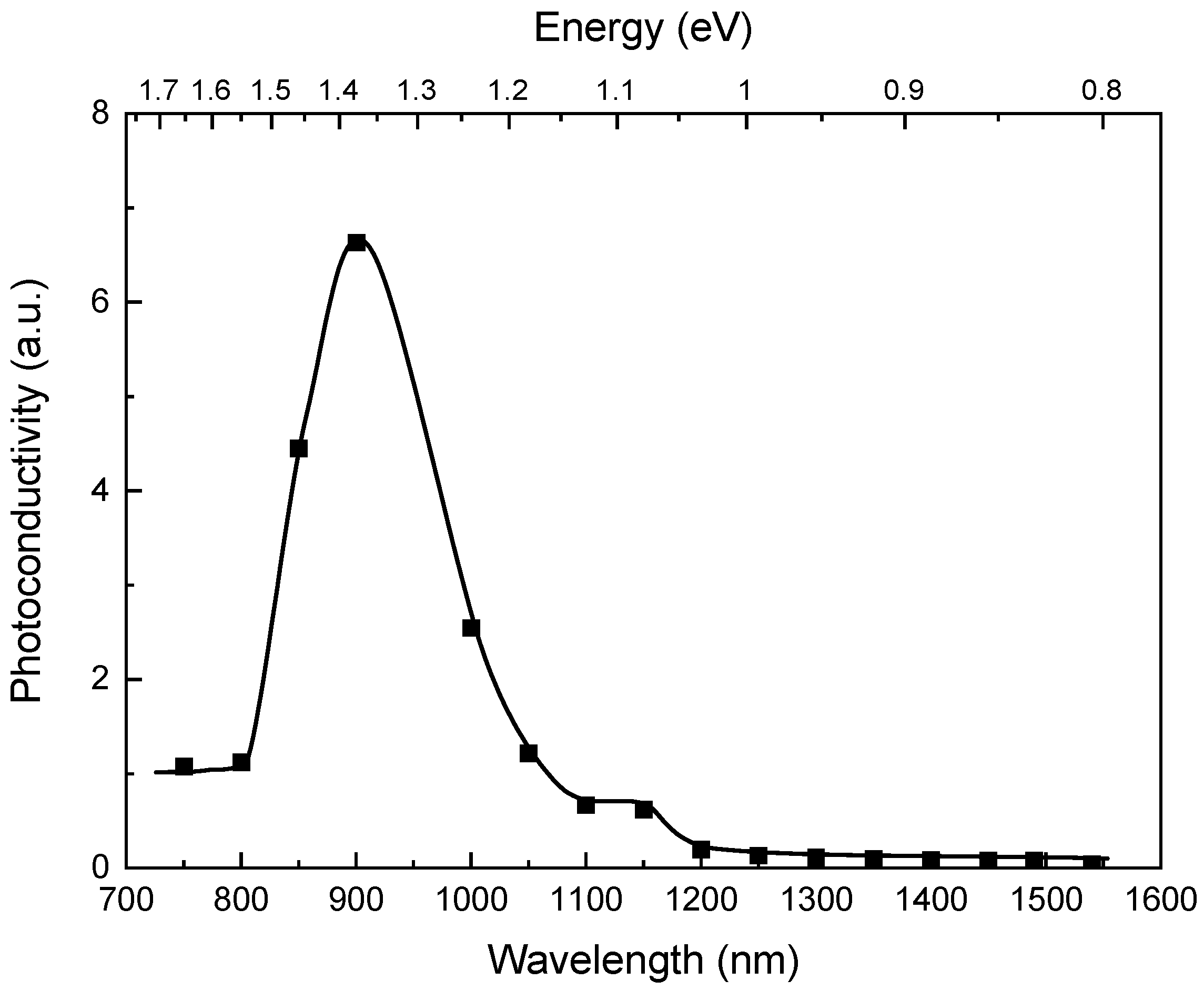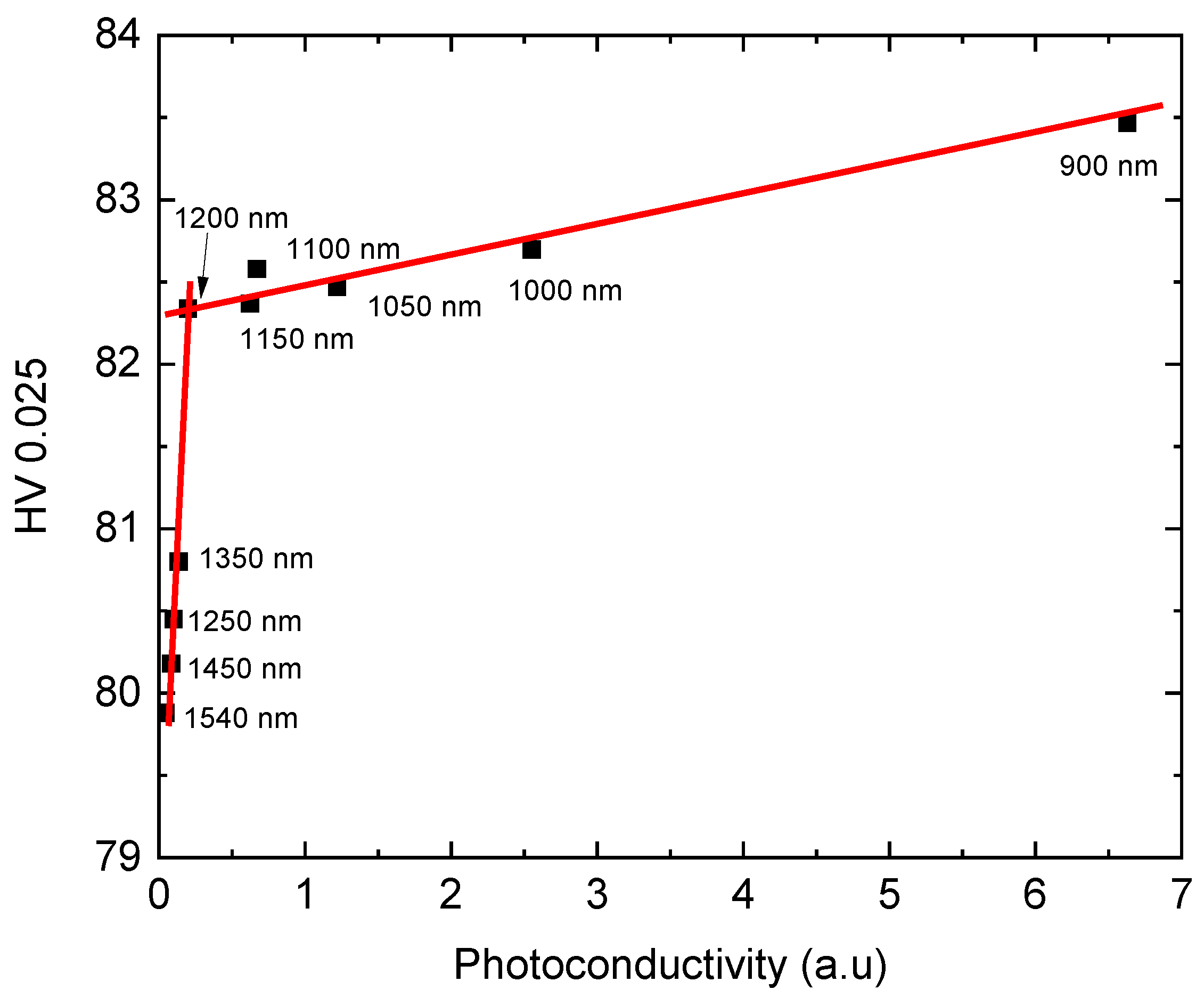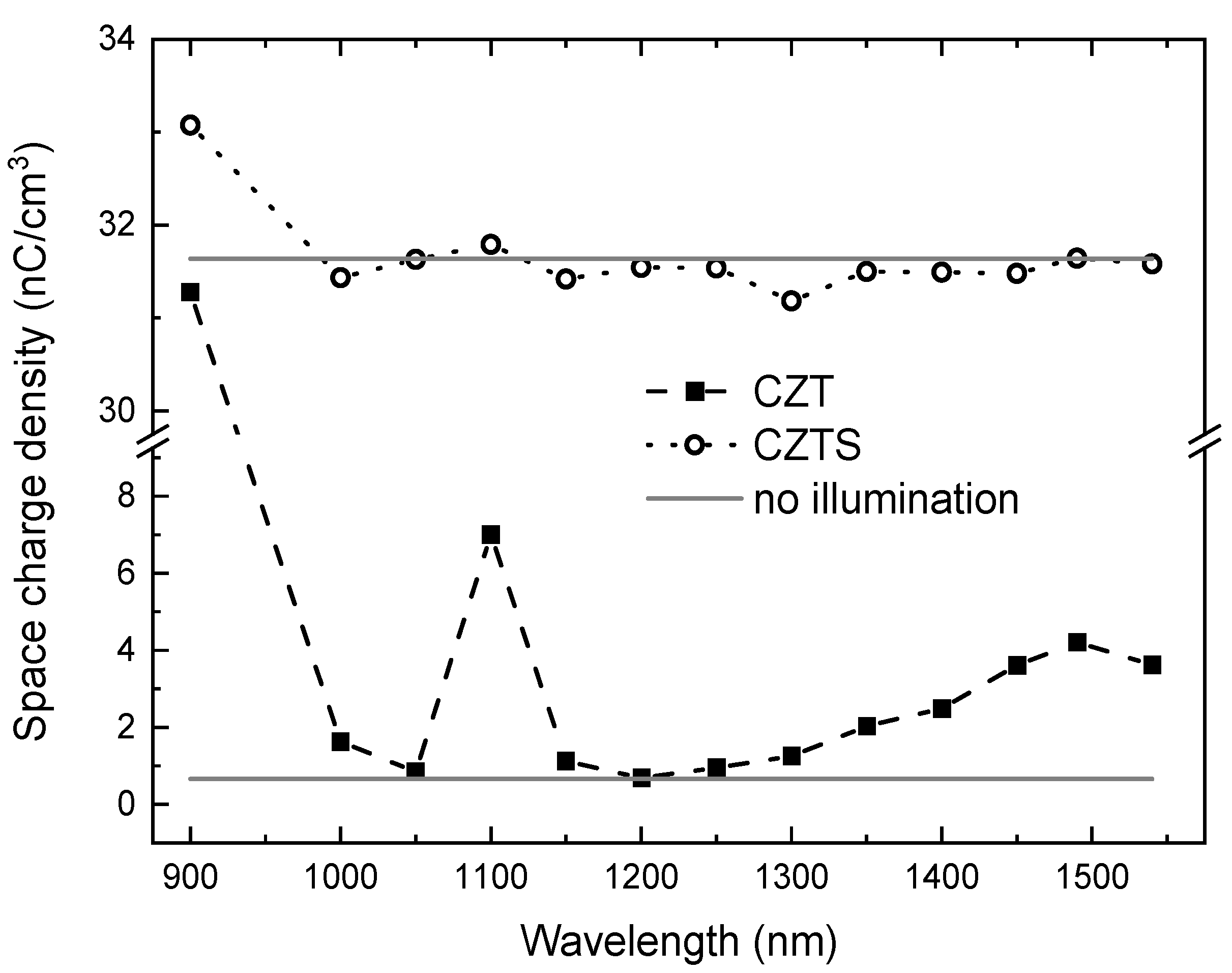Spectral Dependence of the Photoplastic Effect in CdZnTe and CdZnTeSe
Abstract
:1. Introduction
2. Materials and Methods
3. Results
- The microhardness HV0.025 increases upon illumination over the whole applied spectral range (1540–750 nm), indicating a hardening of the material.
- The photoconductivity and Vickers microhardness HV0.025 are well correlated. At specific wavelengths we observed changes in the correlation diagram (change of slope and an abrupt decrease of HV0.025) with decreasing wavelength of the illuminating light.
Author Contributions
Funding
Institutional Review Board Statement
Informed Consent Statement
Data Availability Statement
Acknowledgments
Conflicts of Interest
References
- Burst, J.M.; Duenow, J.N.; Albin, D.S.; Colegrove, E.; Reese, M.O.; Aguiar, J.A.; Jiang, C.-S.; Patel, M.K.; Al-Jassim, M.M.; Kuciauskas, D.; et al. CdTe solar cells with open-circuit voltage breaking the 1 V barrier. Nat. Energy 2016, 1, 1601. [Google Scholar] [CrossRef]
- Schlesinger, T.E.; Toney, J.E.; Yoon, H.; Lee, E.Y.; Brunett, B.A.; Franks, L.; James, R.B. Cadmium zinc telluride and its use as a nuclear radiation detector material. Mater. Sci. Eng. 2001, 32, 103–189. [Google Scholar] [CrossRef]
- Chang, Y.; Grein, C.H.; Zhao, J.; Sivanathan, S.; Wang, C.Z.; Aoki, T.; Smith, D.J.; Wijewarnasuriya, P.S.; Nathan, V. Improve molecular beam epitaxy growth of HgCdTe on CdZnTe (211)B substrates using interfacial layers of HgTe/CdTe superlattices. J. Appl. Phys. 2006, 100, 114316. [Google Scholar] [CrossRef]
- Bell, R.O. Review of optical applications of CdTe. Rev. Phys. Appl. 1977, 12, 391–399. [Google Scholar] [CrossRef]
- Triboulet, R.; Lasbley, A.; Toulouse, B.; Granger, R. Growth and characterization of bulk HgZnTe crystals. J. Cryst. Growth 1986, 79, 695–700. [Google Scholar] [CrossRef]
- Goble, R.J.; Scott, S.D. The relationship between mineral hardness and compressibility (or bulk modulus). Can. Miner. 1985, 23, 273–285. [Google Scholar]
- Williams, D.J. Yield and hardness of CdTe and CdZnTe. In EMIS Data Reviews Series No. 10; Capper, P., Ed.; INSPEC: London, UK, 1994; pt. B2.6, p. 420. [Google Scholar]
- Osip’yan, Y.A.; Petrenko, V.F. Nature of Photoplastic Effect. Sov. Phys. Jetp 1973, 36, 916–920. [Google Scholar] [CrossRef]
- Garosshen, T.J.; Galligan, J.M. Photoplasticity and photonic control of dislocation densities in type II-VI semiconductors. J. Appl. Phys. 1995, 78, 5098–5102. [Google Scholar] [CrossRef]
- Carlsson, L.; Ahlquist, C.N. Photoplastic behavior of CdTe. J. Appl. Phys. 1972, 43, 2529–2536. [Google Scholar] [CrossRef]
- Buch, F.; Ahlquist, C.N. Influence of dislocations on the electrical conductivity of CdTe. J. Appl. Phys. 1974, 45, 1756–1761. [Google Scholar] [CrossRef]
- Carlsson, L.; Svensson, C. Photoplastic Effect in ZnO. J. Appl. Phys. 1970, 41, 1652–1656. [Google Scholar] [CrossRef]
- Koubaiti, S.; Couderc, J.J.; Levade, C.; Vanderschaeve, G. Vickers indentation on the (001) face of ZnS sphalerite under UV illumination and in darkness. Crack patterns and rosette microstructure. Acta Mater. 1996, 44, 3279–3291. [Google Scholar] [CrossRef]
- Matsunaga, K.; Hoshina, S.; Ukita, M.; Oshima, Y.; Yokoi, T.; Nakumara, A. Carrier-trapping induced reconstruction of partial-dislocation cores responsible for light-illumination controlled plasticity in an inorganic semiconductor. Acta Mater. 2020, 195, 645–653. [Google Scholar] [CrossRef]
- Bolotnikov, A.E.; Babalola, S.O.; Camarda, G.S.; Chen, H.; Awadalla, S.; Cui, Y.; Egarievwe, S.; Fochuk, P.M.; Hawrami, R.; Hossain, A.; et al. Extended Defects in CdZnTe Radiation Detectors. IEEE Trans. Nucl. Sci. 2009, 56, 1775–1783. [Google Scholar] [CrossRef]
- Babentsov, V.; Boiko, V.; Schepelskii, G.; James, R.B.; Franc, J.; Prochazka, J.; Hlidek, P. Photoluminescence and electric spectroscopy of dislocations-induced electronic levels in semi-insulating CdTe and CdZnTe. J. Lumin. 2010, 130, 1425–1430. [Google Scholar] [CrossRef]
- Babentsov, V.; Boiko, V.; Schepelskii, G.; James, R.; Franc, J.; Prochazka, J.; Hlidek, P. Dislocation-induced electronic levels in semi-insulated CdTe. Nucl. Instr. Meth. A 2011, 633, S81–S82. [Google Scholar] [CrossRef]
- Kanevce, A.; Reese, M.O.; Barnes, T.M.; Jensen, S.A.; Metzger, W.K. The roles of carrier concentration and interface, bulk, and grain-boundary recombination for 25% efficient CdTe solar cells. J. Appl. Phys. 2017, 121, 214506. [Google Scholar] [CrossRef]
- Moseley, J.; Rale, P.; Collin, S.; Colegrove, E.; Guthrey, H.; Kuciauskas, D.; Moutinho, H.; Al-Jassim, M.; Metzger, W.K. Luminescence methodology to determine grain-boundary, grain-interior, and surface recombination in thin-film solar cells. J. Appl. Phys. 2018, 124, 113104. [Google Scholar] [CrossRef]
- Kweon, K.E.; Aberg, D.; Lordi, V. First-principles study of atomic and electronic structures of 60° perfect and 30/90 partial glide dislocations in CdTe. Phys. Rev. B 2016, 93, 174109. [Google Scholar] [CrossRef] [Green Version]
- Rejhon, M.; Franc, J.; Dědič, V.; Kunc, J.; Grill, R. Analysis of trapping and de-trapping in CdZnTe detectors by Pockels effect. J. Phys. D Appl. Phys. 2016, 49, 375101. [Google Scholar] [CrossRef]
- Wang, Y.; Tao, L.; Abbaszadeh, S.; Levin, C.S. Further investigations of a radiation detector based on ionization-induced modulation of optical polarization. Phys. Med. Biol. 2021, 66, 055013. [Google Scholar] [CrossRef]
- Dědič, V.; Fridrišek, T.; Franc, J.; Kunc, J.; Rejhon, M.; Roy, U.N.; James, R.B. Mapping of inhomogeneous quasi-3D electrostatic field in electro-optic materials. Sci. Rep. 2021, 11, 2154. [Google Scholar] [CrossRef]
- Kim, K.H.; Bolotnikov, A.E.; Camarda, G.S.; Hossain, A.; Gul, R.; Yang, G.; Cui, Y.; Prochazka, J.; Franc, J.; Hong, J.; et al. Defect levels of semi-insulating CdMnTe:In crystals. J. Appl. Phys. 2011, 109, 113715. [Google Scholar] [CrossRef]
- Omling, P.; Weber, E.R.; Montelius, L.; Alexander, H.; Michel, J. Electrical properties of dislocations and point defects in plastically deformed silicon. Phys. Rev. B 1985, 32, 6571. [Google Scholar] [CrossRef] [Green Version]
- Wosinski, T. Evidence for the electron traps at dislocations in GaAs crystals. J. Appl. Phys. 1989, 65, 1566. [Google Scholar] [CrossRef]







Publisher’s Note: MDPI stays neutral with regard to jurisdictional claims in published maps and institutional affiliations. |
© 2021 by the authors. Licensee MDPI, Basel, Switzerland. This article is an open access article distributed under the terms and conditions of the Creative Commons Attribution (CC BY) license (http://creativecommons.org/licenses/by/4.0/).
Share and Cite
Franc, J.; Dědič, V.; Moravec, P.; Rejhon, M.; Grill, R.; Elhadidy, H.; Šíma, V.; Cieslar, M.; Bratko, M.; Roy, U.; et al. Spectral Dependence of the Photoplastic Effect in CdZnTe and CdZnTeSe. Materials 2021, 14, 1465. https://doi.org/10.3390/ma14061465
Franc J, Dědič V, Moravec P, Rejhon M, Grill R, Elhadidy H, Šíma V, Cieslar M, Bratko M, Roy U, et al. Spectral Dependence of the Photoplastic Effect in CdZnTe and CdZnTeSe. Materials. 2021; 14(6):1465. https://doi.org/10.3390/ma14061465
Chicago/Turabian StyleFranc, Jan, Václav Dědič, Pavel Moravec, Martin Rejhon, Roman Grill, Hassan Elhadidy, Vladimír Šíma, Miroslav Cieslar, Maroš Bratko, Utpal Roy, and et al. 2021. "Spectral Dependence of the Photoplastic Effect in CdZnTe and CdZnTeSe" Materials 14, no. 6: 1465. https://doi.org/10.3390/ma14061465





